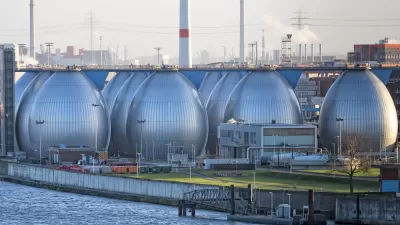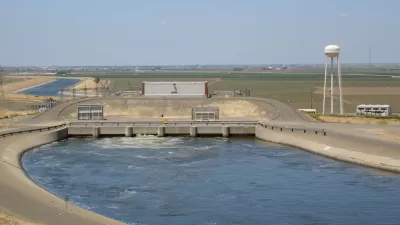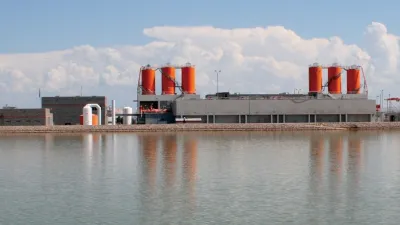Theft by illegal marijuana grow operations is straining California's already dwindling water supplies and endangering local communities as authorities lock hydrants and restrict access to water sources.

"As drought grips most of California, water thievery across the state has increased to record levels," writes Julie Cart, straining resources and causing concern in small communities dependent on scarce supplies.
Bandits in water trucks are backing up to rivers and lakes and pumping free water they sell on a burgeoning black market. Others, under cover of darkness, plug into city hydrants and top up. Thieves also steal water from homes, farms and private wells, and some even created an elaborate system of dams, reservoirs and pipelines during the last drought. Others are MacGyvering break-ins directly into pressurized water mains, a dangerous and destructive approach known as hot-tapping.
Northern California faces a similar problem as water theft has started to deplete the Russian River and other important waterways. "In one water district there, thefts from hydrants could compromise a limited water supply for fighting fires, which is why they have put locks on hydrants."
"No cache of water is safe. During the last major drought, businesses, schools and even a fire station were victims of water theft. In 2014, thieves pumped water from storage tanks belonging to the North San Juan Fire Protection District in Nevada County, in the mountains northeast of Sacramento." In the Sierra Nevada, Nevada County estimates that it is home to close to 4,000 illegal operations, while "[i]n the Antelope Valley, illegal grows have doubled from 200 last year to 400 today, according to county data, while other estimates put the number in the thousands."
While marijuana uses about the same amount of water as a tomato plant, all told, the illegal operations use around 5.4 million gallons per day, straining California's already limited supply as authorities struggle to understand and address the problem. "The state Water Resources Board, which has a modest cadre of 80 investigators who track water diversion and theft from California’s rivers and streams, cannot begin to keep up with the epidemic of stolen water. Nor is the agency’s $1,000 a day fine for water theft proving to be an effective deterrent to offset the rewards for a multi-billion dollar criminal industry." Recently, "the Los Angeles County Board of Supervisors, fed up with water theft and their lack of authority to address it, passed a resolution to petition state legislators to give them power to prosecute water theft, especially during severe droughts."
California can learn from Australia's experience with a similar issue. On the arid island nation, authorities created a powerful new agency to stem the illegal siphoning of water. The agency includes "a large enforcement team backed by fines and the threat of revocation of water licenses" and uses "satellite images, drones, remote-controlled watercraft and software that compares what’s growing on farms with their legal water allocation." As droughts intensify and water becomes more scarce, California must take steps to enhance its own enforcement and protect this vital resource.
FULL STORY: Thieves are stealing California’s scarce water. Where’s it going? Illegal marijuana farms

Planetizen Federal Action Tracker
A weekly monitor of how Trump’s orders and actions are impacting planners and planning in America.

Congressman Proposes Bill to Rename DC Metro “Trump Train”
The Make Autorail Great Again Act would withhold federal funding to the system until the Washington Metropolitan Area Transit Authority (WMATA), rebrands as the Washington Metropolitan Authority for Greater Access (WMAGA).

The Simple Legislative Tool Transforming Vacant Downtowns
In California, Michigan and Georgia, an easy win is bringing dollars — and delight — back to city centers.

The States Losing Rural Delivery Rooms at an Alarming Pace
In some states, as few as 9% of rural hospitals still deliver babies. As a result, rising pre-term births, no adequate pre-term care and "harrowing" close calls are a growing reality.

The Small South Asian Republic Going all in on EVs
Thanks to one simple policy change less than five years ago, 65% of new cars in this Himalayan country are now electric.

DC Backpedals on Bike Lane Protection, Swaps Barriers for Paint
Citing aesthetic concerns, the city is removing the concrete barriers and flexposts that once separated Arizona Avenue cyclists from motor vehicles.
Urban Design for Planners 1: Software Tools
This six-course series explores essential urban design concepts using open source software and equips planners with the tools they need to participate fully in the urban design process.
Planning for Universal Design
Learn the tools for implementing Universal Design in planning regulations.
Smith Gee Studio
City of Charlotte
City of Camden Redevelopment Agency
City of Astoria
Transportation Research & Education Center (TREC) at Portland State University
US High Speed Rail Association
City of Camden Redevelopment Agency
Municipality of Princeton (NJ)





























